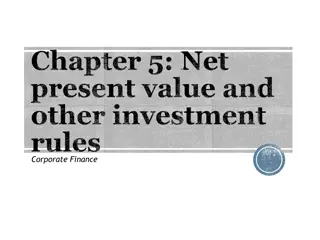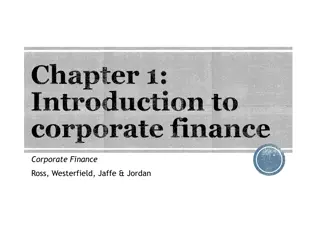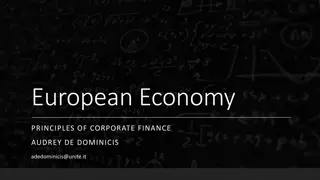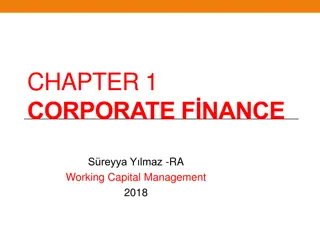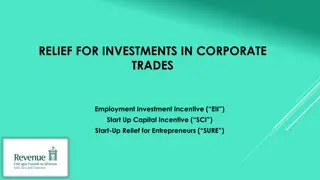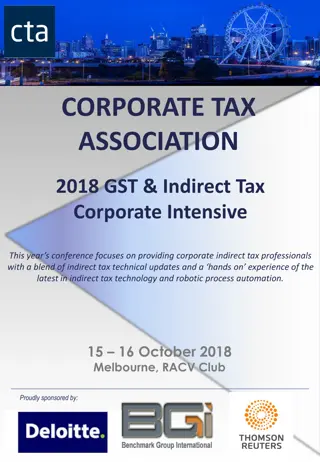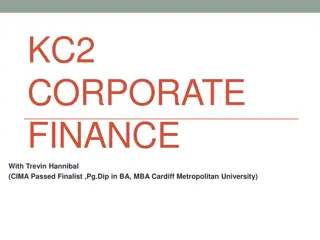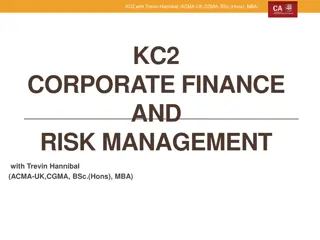Investment Decision Rules and Methods in Corporate Finance
Explore investment decision rules and methods in corporate finance, including calculating NPV, comparing investment projects, payback rule, and internal rate of return. Learn how to select investment projects efficiently based on financial value calculations. Discover the advantages and disadvantages of each rule to make informed decisions for long-term value creation.
Uploaded on Sep 15, 2024 | 0 Views
Download Presentation

Please find below an Image/Link to download the presentation.
The content on the website is provided AS IS for your information and personal use only. It may not be sold, licensed, or shared on other websites without obtaining consent from the author. Download presentation by click this link. If you encounter any issues during the download, it is possible that the publisher has removed the file from their server.
E N D
Presentation Transcript
CORPORATE FINANCE FOR LONG-TERM VALUE Chapter 6: Investment decision rules
Part 2: Discount rates and valuation methods Chapter 6: Investment decision rules
The BIG Picture 3 How to select investment projects? Traditional solution Calculate the net present value (NPV) of projects -> based on FV Do only projects with positive NPV New solution Include also SV and EV to obtain Integrated Present Value (IPV) Analyse the interactions between F, S and E in projects -> internalisation
Calculating financial value 4 The Net Present Value (NPV) method discounts cash flows at their opportunity cost of capital NPV rule: investments with a positive NPV should be undertaken ? ??? ??? = (1 + ?)?> 0 ?=0 Year 2022 2023 2024 2025 2026 2027 2028 2029 -100 25 25 25 25 25 25 25 Cash flow 1.00 0.91 0.83 0.75 0.68 0.62 0.56 0.51 Discount factor -100.0 22.7 20.7 18.8 17.1 15.5 14.1 12.8 PV(Cash flow) NPV 21.7
Calculating financial value 5 Comparing investment projects using NPV method Project X Year 2022 2023 2024 2025 2026 2027 2028 2029 -100 25 25 25 25 25 25 25 Cash flow 1.00 0.91 0.83 0.75 0.68 0.62 0.56 0.51 Discount factor NPV per euro invested: 21.7 / 100 = 21.7% -100.0 22.7 20.7 18.8 17.1 15.5 14.1 12.8 PV(Cash flow) NPV 21.7 Project Y NPV per euro invested: 11.65 / 50 = 23.3% Year 2022 2023 2024 2025 2026 2027 2028 2029 -50 20 20 20 5 5 5 5 Cash flow 1.00 0.91 0.83 0.75 0.68 0.62 0.56 0.51 Discount factor -50.0 18.2 16.5 15.0 3.4 3.1 2.8 2.6 PV(Cash flow) If project Y can be duplicated, then Y > X NPV 11.65
Payback rule 6 Payback rule: only do an investment if its cash flows pay back the initial investment within a pre-specified period The payback period is the number of years needed to earn back the initial investment Advantages: ease of use Disadvantages: Payback period is usually arbitrarily determined Does not account for time value of money Makes cash flows after cut-off point irrelevant (reinforcing short-termism)
IRR rule 7 The internal rate of return (IRR) is the discount rate at which a project s NPV equals zero IRR Rule: do investment if IRR > opportunity cost of capital Year 2022 2023 2024 2025 2026 2027 2028 2029 Using trial and error or the IRR formula in Excel: r = 0.163 -100 25 25 25 25 25 25 25 Cash flow 1 1 1 1 1 1 1 1.00 Discount factor (1 + ?)1 (1 + ?)2 (1 + ?)3 (1 + ?)4 (1 + ?)5 (1 + ?)6 (1 + ?)7 -100.0 PV(Cash flow) ? ? ? ? ? ? ? NPV 0 Advantage: indicates safety Disadvantage: not useful in comparing projects of different sizes
IRR rule 8 Year 2022 2023 2024 2025 2026 2027 2028 2029 Problem when CF sign flips -200 110 110 110 -60 110 110 -300 CF project A several times (like project A) -150 30 30 30 30 30 30 30 CF project B NPV vs discount rate 60 For project A, there are two 40 project B 20 points at which NPV = 0, so project A NPV 0 there s no unique solution 1% 2% 3% 4% 5% 6% 7% 8% 9% 10% 11% 12% 13% 14% 15% 16% 17% 18% 19% 20% 21% 22% 23% 24% -20 -40 -60 Discount rate NPV - no IRR NPV - clear IRR
NPV vs IRR and payback 9 Preference for NPV, since: NPVs can be added up It is a direct measure of value created for shareholders (the manager s primary objective) Project Y twice Method Project X Project Y Preferred project 21.7 11.6 23.3 Project Y twice NPV 16.3% 19.6% 19.6% Project Y or Project Y twice IRR 4 3 3 Project Y or Project Y twice Payback rule
Behavioural effects on investment decisions 10 People often behave irrationally in corporate investment decisions Internal errors are misvaluations by corporate managers Overconfidence: underestimating the risk of investments, resulting in a lower discount rate Excessive optimism: overestimation of cash flows Ways to spot internal errors: prematurely liquidating options, earnings missed and excessive press coverage External errors are misvaluations by participants in financial markets Behavioural biases, e.g., availability bias and confirmation bias
Overconfidence and excessive optimism 11 Problem Manager B Manager C Manager A Unbiased Suppose three managers assess the same project. The table (right) gives their individual estimates of project risk and expected cash flows, as well as an unbiased assessment of project risk and CFs. 8% 7.5% 8% 7.5% Project risk 200 200 220 220 Perpetual CF 1. What is the unbiased project value? 2. How much do managers A, B and C think the project is worth?
Overconfidence and excessive optimism 12 Solution Manager B Manager C Manager A Unbiased 1. What is the unbiased project value? ?? =?? =200 0.08= ???? ? 7.5% 7.5% 8% 8% Project risk How much do managers A, B and C think the 2. 220 220 200 200 Perpetual CF project is worth? 200 0.075= ????.? Manager A: Overconfidence resulting in a lower risk assessment 220 0.08= ???? Manager B: Excessive optimism resulting in a higher CF projection 220 0.075= ????.? Manager A: Both overconfidence and excessive optimism = highest overvaluation
Integrated investment decision rules 13 Three ways to prioritise investments: Constrained PV: includes S and E in own units as budget constraint for example: net zero CO2emissions; positive health effects Expanded PV: expresses S and E in monetary values and adds to FV for example: CO2emissions x shadow carbon price; health effects x shadow price Integrated PV: balances FV, SV and EV in formula: ??? = ?? + ? ?? + ? ?? with ?,? > 0
Constrained PV 14 S and/or E function as a budget constraint to the standard NPV on F Investment, millions NPV F, millions CO2 emitted, millions CO2stored, millions Contribution to CO2 emissions 0? Project NPV 0? 70 -50 0 1 no yes A 100 200 0.2 0 yes no B 20 250 0.2 0 yes no C Project A contributes to becoming neutral but has a negative NPV, so fails on the constrained PV criterion Project B and C have positive NPVs but do not contribute to becoming neutral, so also fail on the constrained PV criterion
Constrained PV 15 Combining projects might lead to value creation Investment, millions NPV F, millions CO2 emitted, millions CO2stored, millions Contribution to CO2 emissions 0? Project NPV 0? A 70 -50 0 1 no yes B 100 200 0.2 0 yes no C 20 170 90 250 150 200 0.2 0.2 0.2 0 1 1 yes yes yes no yes yes A+B A+C Combing both A with B and A with C contribute to becoming carbon neutral and have a positive NPV, so can both be accepted A with C has a higher NPV compared to A with B, so A with C is preferred Potential issues: netting pros and cons & including other E and S issues
Expanded PV 16 Expresses S and E in monetary values to arrive at SV and EV and then shows these in addition to the standard NPV S in own units quality life years added - 2,500 4,000 4,000 EV ( millions) net CO2reduction at 200 Euro/ton 200 -40 -40 160 SV ( millions) quality life years added at 110k Euro/life 0 275 440 440 Investment, millions NPV F, millions E in own units net CO2reduction Project 70 100 20 90 -50 200 250 200 1.0 -0.2 -0.2 0.8 A B C A+C Project A and C combined looks much better than any individual project, being strongly positive on all three value dimensions
Integrated PV = IPV 17 SV and EV are not only separately calculated but also added and weighted, along with the NPV to arrive at an integrated value creation number Simple integrated present value decision model: ??? = ?? + ?? + ?? > 0 Project FV -50 200 250 200 SV 0 275 440 440 EV 200 -40 -40 160 IPV=FV+SV+EV 150 435 650 800 A B C A+C
IPV 18 A company should avoid conducting projects whereby a positive FV outweighs negative SV and EV Applying different regimes, with b denoting the weighting of SV and c denoting the weighting of EV ??? = ?? + ? ?? + ? ?? > 0 ??? ?,? > 0 The IPV model acknowledges the interrelationships between the different types of values and allows a structured balancing of stakeholder interests Current corporate governance regime: b = c = 0.1
IPV 19 Intermediate case: b = c = 0.5 Full case: b = c = 1 IPV = Project FV SV EV IPV=FV+SV+EV FV+0.5*SV+0.5*EV 50 30 10 -50 30 60 -20 -40 -40 15 25 20 -20 20 30 K L M Which project to choose? Intermediate case: choose project L Full case: choose project M
Internalisation 20 The three value dimensions (FV, SV and EV) are created jointly, and with similar drivers, and therefore interact and affect each other Taking a dynamic perspective is very important: do not assume the current conditions will last forever, but acknowledge that they can change Current loss-making entities may become profitable as their positive externalities get priced Profitable entities with large negative externalities face the risk of those externalities being (partly) internalised
Internalisation 21 IPV = Project FV SV EV FV+0.5*SV+0.5*EV X Y Z 80 -20 -40 -20 -30 -50 -50 40 60 45 -15 -35 Internalisation due to carbon tax, so FV absorbs 75% of EV FV (new) = FV (old) + 0.75*EV IPV with internalisation IPV without internalisation Project FV (old) SV EV X Y Z 80 -20 -40 -20 -30 -50 -50 40 60 42.5 10 5 7.5 15 10 45 -15 -35 With internalisation, project Y becomes more attractive
Internalisation 22 The probability of internalisation estimates to what extent externalities are likely to be translated into FV effects, driven by transition processes Expected IPV of project Y under varying probabilities of internalisation Probability of no internalisation 100% 90% 80% 70% 60% 50% 40% 30% 20% 10% 0% IPV with internalisation Probability of internalisation IPV without internalisation Expected IPV 15 15 15 15 15 15 15 15 15 15 15 0% 10% 20% 30% 40% 50% 60% 70% 80% 90% 100% -15 -15 -15 -15 -15 -15 -15 -15 -15 -15 -15 -15 -12 -9 -6 -3 0 3 6 9 12 15
Conclusions 23 When making investment decisions, companies need to be able to compare various investment opportunities - NPV, payback period and IRR Combining NPV with E and S: constrained PV, expanded PV and integrated PV F, S and E all weigh in and can be prioritised ideally informed by the company s purpose and value creation profile Internalisation can happen, thereby shifting EV or SV to FV in positive or negative ways







